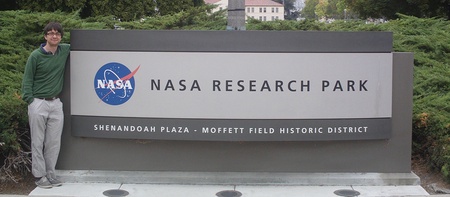An Aberdeen scientist is reaching for the stars and beyond after securing an internship at NASA in California.
Sean McMahon, a PhD student at the University of Aberdeen, has spent the last two months at the space agency’s Ames Research Centre in the heart of Silicon Valley.
Sean’s studies in Aberdeen focus on examining the possibility of life on Mars and other planets by conducting research in geology and microbiology, and he has taken time off from his PhD to take up the competitive internship.
“I feel very lucky to work at NASA. I try not to behave too much like a tourist but I have stocked up on NASA-branded t-shirts, stickers and pens from the on-site shop!” he said.
“The NASA Ames Research Centre is a terrific place and a lot of exciting things happen here. Some very famous spacecraft have been built here. There are parts of old Titan rockets lying around which date back to the 1960s.
“I watched the LADEE mission (an unmanned moon probe designed at Ames) launch on a big screen on the lawn at NASA the other evening and there was a festival atmosphere.
“My research is funded by the Science & Technology Facilities Council as part of the UK's contribution to a European Space Agency (ESA) programme. So I am more familiar with ESA than with NASA. However, after publishing papers in astrobiology journals, my supervisor and I received letters asking us if we knew any graduate students who would be interested in participating in the NASA Planetary Biology Internship programme. I thought, ‘yes, me!’ My supervisor John Parnell was very supportive of my application even though I am taking two months off from my PhD to be here.”
Sean’s work at NASA is driven towards finding a way for astronauts to be able to make their own medicines whilst in space. The project is supervised by microbiologist Rocco Mancinelli and engineer Michael Flynn.
“The cost of space missions is largely determined by the mass of the material that needs to be carried into space, so there is always an incentive to minimize this mass.
“The aim is to allow astronauts to produce their own medicines quickly and efficiently so that stockpiles of drugs do not have to be carried into space. This is particularly important for long-duration missions, such as Mars.
“My work for the NASA Planetary Biology internship involves bacteria that are genetically modified to produce medicines (and potentially other useful compounds) in a machine that can harvest the product on a spacecraft. Specifically, I am performing microbiology experiments to determine what the specifications of the machine need to be.”
As well as being a career highlight to date, Sean feels his time at NASA has had great benefits for his career.
“I’ve gained new insight into the way that NASA commissions and carries out research and learned some new techniques in microbiology and molecular biology that may be useful in my future research. Perhaps most importantly, I’ve met other researchers from around the world who share my interests and with whom I may be able to work again in the future.
“I’d love to come back here one day. It’s a fantastic place to work and I’d advise other Aberdeen PhD students in geology, biology, physics and chemistry to consider applying for internships here.”


